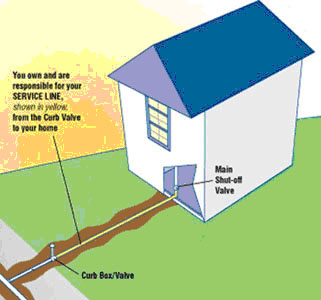 Although some poly piping problems stem from improper installation, most complaints are with the integrity of the piping itself. Polybutylene pipe is known to deteriorate due to contact with oxidants normally found in public water supplies. The failure can occur in the plastic fittings or in the pipe itself. A main concern regarding poly pipe is that, since the oxidants are carried in the water, the pipe deteriorates from the inside. This makes it very difficult to determine if the pipe is truly in good condition. Most home inspectors cannot give a reliable assessment on the condition of poly piping unless there is a visible problem with the exterior of the pipe or its installation. In addition, when a leak occurs, it may be extremely severe because the deterioration occurs from within.
Although some poly piping problems stem from improper installation, most complaints are with the integrity of the piping itself. Polybutylene pipe is known to deteriorate due to contact with oxidants normally found in public water supplies. The failure can occur in the plastic fittings or in the pipe itself. A main concern regarding poly pipe is that, since the oxidants are carried in the water, the pipe deteriorates from the inside. This makes it very difficult to determine if the pipe is truly in good condition. Most home inspectors cannot give a reliable assessment on the condition of poly piping unless there is a visible problem with the exterior of the pipe or its installation. In addition, when a leak occurs, it may be extremely severe because the deterioration occurs from within.
Poly pipe leaks are unpredictable and there are no symptoms to warn of an impending leak. Some factors that affect polybutylene piping adversely can include:
- Poor installation
- Water quality
- Pipe age
- Chlorine levels
- Deterioration of fittings (both metal and plastic)
When polybutylene pipe reacts with the oxidants in normal tap water, it becomes brittle, sometimes scaling or flaking. This results in a fracturing of the interior surface of the pipe, which allows for more deterioration. Eventually the pipe will begin to leak, causing damage throughout a home. Poly pipe with plastic fittings or with metal fittings will eventually incur damage; poly piping is not a reliable piping under any circumstances. If a pipe has been leaking for some time without the knowledge of a homeowner, severe structural damage to the home can result, making repairs extremely difficult.
Damage from polybutylene pipe leaks can be expensive, in some cases more than the original cost of the house. Insurance companies sometimes cancel or refuse policies for homes with known poly piping problems, and it is difficult to market a home that has such an unreliable plumbing system.